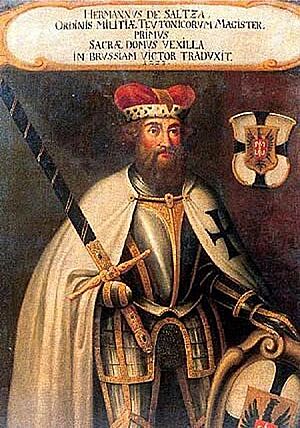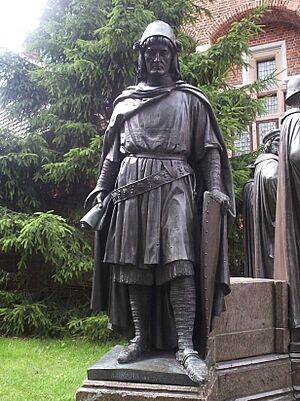Hermann von Salza facts for kids

Hermann von Salza (born around 1165 – died March 20, 1239) was a very important leader of the Teutonic Knights. He was their fourth Grand Master, serving from 1210 to 1239. Hermann was a skilled diplomat, meaning he was good at talking to leaders and solving problems peacefully. He had strong connections with Emperor Frederick II and the Pope. During his time as Grand Master, the military order grew a lot, especially into the region of Prussia.
Contents
Who Was Hermann von Salza?
Hermann von Salza was born into a family of important officials in Thuringia, a region in Germany. He was likely born at Dryburg Castle in Langensalza. He might have joined the Siege of Acre between 1189 and 1191. This was where the Teutonic Order was first created. He may also have joined another Crusade of 1197 later on.
The exact time Hermann joined the Teutonic Order is not known. However, he first appeared as their Grand Master in 1210. This was at the crowning of Count John of Brienne as King of Jerusalem. During his early years as Grand Master, the Knights expanded their activities. They spread from Spain all the way to Livonia.
Hermann's Important Connections
Hermann became a close friend and advisor to Emperor Frederick II. He often acted as a go-between for the Emperor and the Pope starting in 1222. Pope Honorius III also saw how capable Hermann was. The Pope gave the Teutonic Knights the same high status as the Knights Hospitaller and the Knights Templar. This was a big deal, as the Teutonic Knights had been struggling before Hermann took charge.
In 1211, King Andrew II of Hungary asked Hermann to send Teutonic Knights to the Burzenland region. Their job was to defend against the Cumans. However, Hungarian nobles complained about the Knights being there. Because of this, the Knights were forced to leave by 1225.
Meanwhile, Hermann went with Emperor Frederick on the Fifth Crusade in 1219. They fought against Damietta. Hermann was honored for his bravery during this crusade. He later convinced Frederick to go on the Sixth Crusade. He also played a part in arranging Frederick's marriage to Isabella, who was John of Brienne's daughter.
Fighting in Prussia and Later Life
After returning to Europe, Hermann helped to end a conflict called the War of the Keys. He also helped lift the excommunication of Emperor Frederick. Excommunication meant that the Pope had banned Frederick from the Church.
Later, Konrad I of Masovia asked Hermann to help fight the Old Prussians. These people followed pagan beliefs. After Hermann got approval from both the Pope and the Emperor, the Knights began their long campaign. In 1230, they started working to Christianize Prussia.
Hermann's many visits with the Pope and the Emperor brought new benefits to the Teutonic Order. He also managed to bring the Livonian Brothers of the Sword into the Teutonic Order in 1237. Hermann was so important as a mediator between Pope Gregory IX and the Emperor. In fact, all communication between them stopped when Hermann died.
However, some knights in the Teutonic Order became unhappy because their Grand Master was often away. They called him back and he stepped away from his political work. But he was less successful as a religious leader. He soon retired to Salerno in 1238. He died there in 1239.
Hermann's Legacy
A marble statue of Hermann von Salza stands in the Spandau Citadel in Berlin. It was originally part of a monument in Berlin's former Siegesallee. A special memorial plaque for Hermann von Salza is also found in the Walhalla memorial near Regensburg.
See also
 In Spanish: Hermann von Salza para niños
In Spanish: Hermann von Salza para niños


